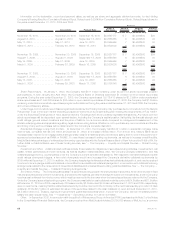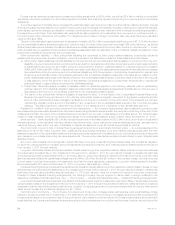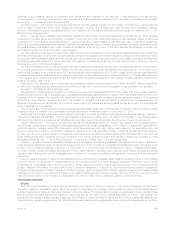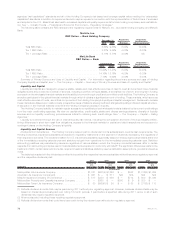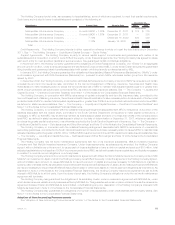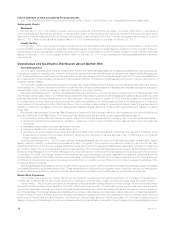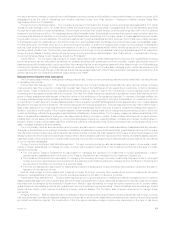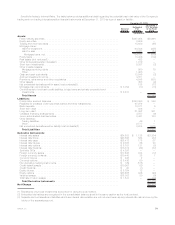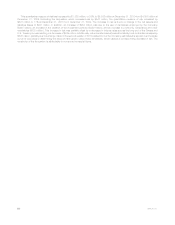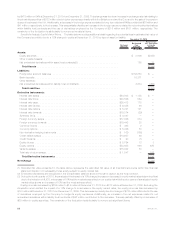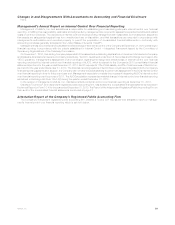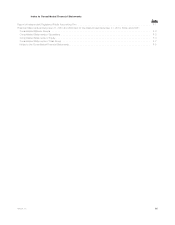MetLife 2010 Annual Report Download - page 79
Download and view the complete annual report
Please find page 79 of the 2010 MetLife annual report below. You can navigate through the pages in the report by either clicking on the pages listed below, or by using the keyword search tool below to find specific information within the annual report.Future Adoption of New Accounting Pronouncements
See “Future Adoption of New Accounting Pronouncements” in Note 1 of the Notes to the Consolidated Financial Statements.
Subsequent Events
Dividends
On February 18, 2011, the Holding Company announced dividends of $0.2500000 per share, for a total of $6 million, on its Series A
preferred shares, and $0.4062500 per share, for a total of $24 million, on its Series B preferred shares, subject to the final confirmation that it
has met the financial tests specified in the Series A and Series B preferred shares, which the Company anticipates will be made on or about
March 7, 2011. Both dividends will be payable March 15, 2011 to shareholders of record as of February 28, 2011.
Credit Facility
On February 1, 2011, the Holding Company entered into a committed facility with a third-party bank to provide letters of credit for the
benefit of MoRe, a captive reinsurance subsidiary, to address its short-term solvency needs based on guidance from the regulator. This one-
year facility provides for the issuance of letters of credit in amounts up to $350 million. Under the facility, a letter of credit for $250 million was
issued on February 2, 2011 and increased to $295 million on February 23, 2011, which management believes satisfies MoRe’s solvency
requirements.
Quantitative and Qualitative Disclosures About Market Risk
Risk Management
The Company must effectively manage, measure and monitor the market risk associated with its assets and liabilities. It has developed an
integrated process for managing risk, which it conducts through its Enterprise Risk Management Department, Asset/Liability Management
Unit, Treasury Department and Investment Department along with the management of the business segments. The Company has established
and implemented comprehensive policies and procedures at both the corporate and business segment level to minimize the effects of
potential market volatility.
The Company regularly analyzes its exposure to interest rate, equity market price and foreign currency exchange rate risks. As a result of
that analysis, the Company has determined that the estimated fair values of certain assets and liabilities are materially exposed to changes in
interest rates, foreign currency exchange rates and changes in the equity markets.
Enterprise Risk Management. MetLife has established several financial and non-financial senior management committees as part of its
risk management process. These committees manage capital and risk positions, approve ALM strategies and establish appropriate corporate
business standards. Further enhancing its committee structure, during the second quarter of 2010, MetLife created an Enterprise Risk
Committee made up of the following voting members: the Chief Financial Officer, the Chief Investment Officer, the President of U.S. Business,
the President of International and the Chief Risk Officer. This committee is responsible for reviewing all material risks to the enterprise and
deciding on actions if necessary, in the event risks exceed desirable targets, taking into consideration best practices to resolve or mitigate
those risks.
MetLife also has a separate Enterprise Risk Management Department, which is responsible for risk management throughout MetLife and
reports to MetLife’s Chief Risk Officer. The Enterprise Risk Management Department’s primary responsibilities consist of:
• implementing a corporate risk framework, which outlines the Company’s approach for managing risk on an enterprise-wide basis;
• developing policies and procedures for managing, measuring, monitoring and controlling those risks identified in the corporate risk
framework;
• establishing appropriate corporate risk tolerance levels;
• deploying capital on an economic capital basis; and
• reporting on a periodic basis to the Finance and Risk Committee of the Company’s Board of Directors; with respect to credit risk, to the
Investment Committee of the Company’s Board of Directors; and, reporting on various aspects of risk, to financial and non-financial
senior management committees.
Asset/Liability Management. The Company actively manages its assets using an approach that balances quality, diversification, asset/
liability matching, liquidity, concentration and investment return. The goals of the investment process are to optimize, net of income tax, risk-
adjusted investment income and risk-adjusted total return while ensuring that the assets and liabilities are reasonably managed on a cash flow
and duration basis. The ALM process is the shared responsibility of the Financial Risk Management and Asset/Liability Management Unit,
Enterprise Risk Management, the Portfolio Management Unit, and the senior members of the business segments and is governed by the ALM
Committees. The ALM Committees’ duties include reviewing and approving target portfolios, establishing investment guidelines and limits
and providing oversight of the ALM process on a periodic basis. The directives of the ALM Committees are carried out and monitored through
ALM Working Groups which are set up to manage by product type. In addition, an ALM Steering Committee oversees the activities of the
underlying ALM Committees.
MetLife establishes target asset portfolios for each major insurance product, which represent the investment strategies used to profitably
fund its liabilities within acceptable levels of risk. These strategies are monitored through regular review of portfolio metrics, such as effective
duration, yield curve sensitivity, convexity, liquidity, asset sector concentration and credit quality by the ALM Working Groups.
Market Risk Exposures
The Company has exposure to market risk through its insurance operations and investment activities. For purposes of this disclosure,
“market risk” is defined as the risk of loss resulting from changes in interest rates, foreign currency exchange rates and equity market.
Interest Rates. The Company’s exposure to interest rate changes results most significantly from its holdings of fixed maturity securities,
as well as its interest rate sensitive liabilities. The fixed maturity securities include U.S. and foreign government bonds, securities issued by
government agencies, corporate bonds and mortgage-backed securities, all of which are mainly exposed to changes in medium- and long-
term interest rates. The interest rate sensitive liabilities for purposes of this disclosure include debt, policyholder account balances related to
certain investment type contracts, and net embedded derivatives on variable annuities with guaranteed minimum benefits which have the
same type of interest rate exposure (medium- and long-term interest rates) as fixed maturity securities. The Company employs product
design, pricing and ALM strategies to reduce the adverse effects of interest rate movements. Product design and pricing strategies include
76 MetLife, Inc.




